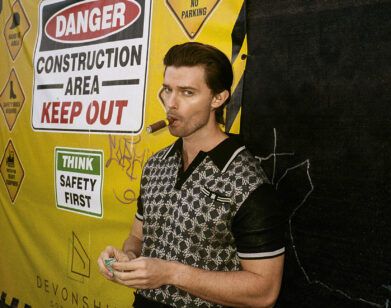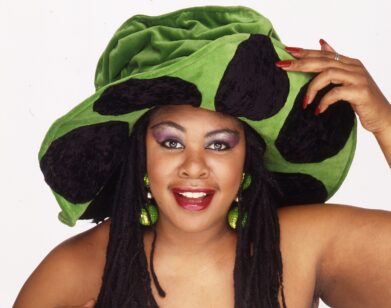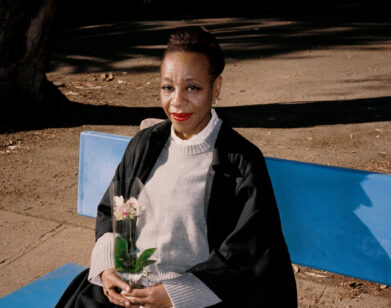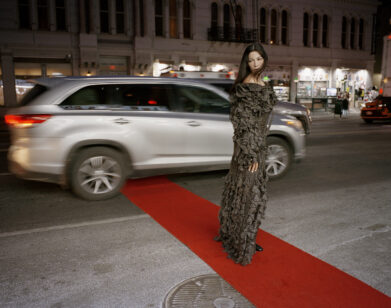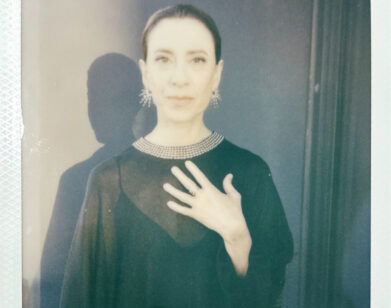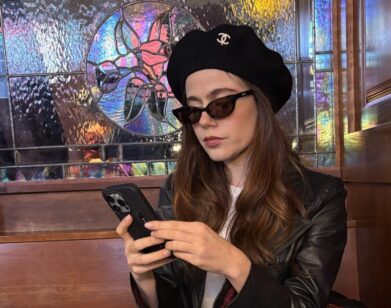How Dee Rees Built a Cocoon
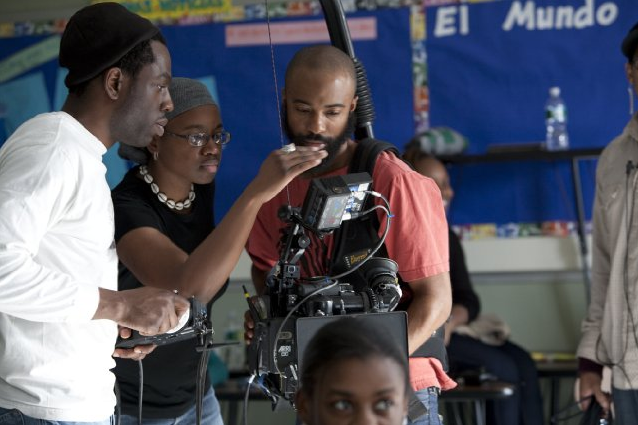
ABOVE: DEE REES (CENTER) FILMING PARIAH.
Blowing up the indie film world is emerging writer and director, Dee Rees, whose new film Pariah is sweeping up awards and recognition—including a Gotham Independent Film Award for Breakthrough Director and two nominations for the Independent Spirit Awards. Also a Sundance World Premiere, this dark and inspiring coming-of-age drama, starring Adepero Oduye as Alike, a teenager in Brooklyn coming to grips with her sexuality, will be out in selected theaters December 28. We spoke with the lovely Spike Lee protégée at a place that couldn’t have been more different from the setting of film, the Waldorf-Astoria.
DEENAH VOLLMER: Let’s start with your background. I understand you have a Master’s in business administration. How did you go from business to film?
DEE REES: I’ve always liked to write, but I never thought I could make a career out of it. I went to business school because in the ’80, it was the thing to do. I thought that marketing was a way to be creative in business, but quickly learned all creative stuff happens at the ad agency. My first job out of business school was at Procter and Gamble in Cincinnati, Ohio selling panty liners. [laughs] I got laid off, moved to New York, and worked for a company called Schering-Plough where I sold bunion pads and wart removers for Dr. Scholl’s. It was kind of an upgrade from panty liners. I was on a shoot for a shoe insole, and I liked being on set. I asked one of the ad guys how to get into something like this, and he said, “You have to go to film school.” And I was like, “Okay. So what film schools do I go to?” “Oh, NYU, but you won’t get in there.” But I applied to NYU and got in and quit my job and went to film school. Now it feels good to be doing what I love for a living.
VOLLMER: Did having a business background help you make informed decisions about making a film on a small budget?
REES: It definitely helps. Filmmaking is the intersection of art and commerce. All that training helped us get investors, business plans, and people to help finance the film.
VOLLMER: I understand Spike Lee is an executive producer on the film. How did that happen?
REES: I interned on a film of his, and he taught master classes at NYU. I would sign up for his office hours, and he’d give me feedback on my script. As we were developing it and starting to fundraise, Nekisa [Cooper] would go to him with her budget. He would sit with his ruler, and go through her 80-page budget and give feedback and ideas on where to cut costs. At this point, he was being a de facto exec producer because he was being a mentor and giving us advice. So Nekisa asked him to come on board officially as an executive producer and he said yes. It was great. He didn’t write us a check, but he gave us his time, which ended up being more valuable.
VOLLMER: You wrote Pariah as a feature, then made it into a short film and then back into a feature again. What changes happened throughout that process?
REES: The characters became better rounded. The original version was more focused on Alike, and in the final version, all the characters became fuller and more dimensional. It also became much more compact. The first draft was 140 pages, and by the time it got done, it was 100 pages. Through that process, through going to the Sundance Lab, I really learned how to work with subtext.
VOLLMER: What was your experience like at the Sundance Lab?
REES: It was amazing. It was my first validation as an artist, and it was the first time I was able to focus exclusively on the work. It was a lesson in learning how to accept criticism and how to look objectively at material. Once your film is done, you can’t explain to people what something was supposed to be. You can’t give them footnotes. It all has to be there. With the Directors Lab, you get to workshop some of the tougher scenes with your actors, and so I used that chance to workshop the love story between Alike and Bina and really get comfortable with it and really get close to the characters and who they are. Initially it was the father who committed the violence against Alike, and by the time I finished it, I realized it had to be the mother.
VOLLMER: Is the film at all autobiographical?
REES: I’m from Nashville, Tennessee, so clearly Brooklyn wasn’t my world and wasn’t what I grew up with. But it’s semi-autobiographical in that like Alike, I struggled with gender identity. When I first started going out to lesbian clubs, I felt a very binary recreation of hetero culture. There are butches and femmes, and I felt like I was neither of those things. I’m in a turtleneck and jeans and just learning to be comfortable in that space. I realized I don’t have to be a certain way.
VOLLMER: Why did you choose to set the film in New York City?
REES: I felt this was a story that could only happen in New York, because in New York there’s a lot of interstitial spaces; spaces in between spaces, where you’re changing, and New York gives you the anonymity to be who you want to be, which couldn’t happen in the South with Alike on a school bus or getting picked up to and from school. This needed to happen in a bigger city, where she would be able to go out and by herself. And because it has a stratified social setting, Brooklyn’s a place where there can be middle-class and working-class [people] right next to each other. The film needed that richness of that environment.
VOLLMER: Two of the elements that really stood out to me in the film were the colors and the clothing. I’m wondering what kind of conscious decisions you made in both of those areas.
REES: In working with Bradford Young, our cinematographer on the color palette, we wanted to use the colors in between the colors: not red, green, and blue, but cyan and magenta. The colors that you can’t quite define, because Alike can’t quite be defined. We wanted to paint her with a lot of color and light, initially, because she’s a chameleon; she’s moving from one world to the next—in the club she’s purple, on the bus she’s green. We wanted her to constantly be painted by her environments, as if she’s blending in. Towards the end we see her more in white light, we see her more in wide shots, as she starts to find herself and is less cocooned.
With the clothes, I did a wardrobe bible where basically it had who the characters were—so Alike’s thrust is that she was kind of cocooned initially, her clothes are very drab, very bulky. Then when she’s with Bina, colors get introduced into her wardrobe, and her clothes become more fitted.
VOLLMER: She gets a scarf.
REES: Exactly. She starts to find herself and starts to be more comfortable and starts to live her life in color, as opposed to Laura, who’s a peacock, so right away she’s pastel, she’s bright, she’s very flamboyant. Laura’s palette stays the same, but as she matures, her dress becomes a little more conservative. For Alike, clothes were really important to show her literally breaking out of this cocoon and becoming this person who’s open to life and open to love.
VOLLMER: You’ve used some animal metaphors in speaking about your characters; is that something that you do a lot?
REES: It wasn’t conscious; it’s just that when you’re talking to a production designer or wardrobe person, it helps to not be literal, to talk in whatever terms get it across. I try to talk in a language that isn’t necessarily film language. It’s a language that’s about visuals and things that we can all access, understand and process. I think it makes it interesting that way, because when you come up with stuff, like, “Okay, Alike’s room is a cocoon,” you can talk to the production designer like, “Have kind of these dark curtains that block out light.” It helps us to think about the story in a different way; it makes it more interesting and more challenging creatively to recreate that. I think those things start to work on a subliminal level, where you’re not conscious of it but it influences the feeling of the film.
VOLLMER: What’s most important to you in filmmaking?
REES: I just want to tell stories that are meaningful and have inspiration to them; people can watch it and take away something or maybe they’ll just think about themselves differently, or thing about the world differently. I just want to create characters that live on.
PARIAH IS OUT IN LIMITED RELEASE DECEMBER 28.

